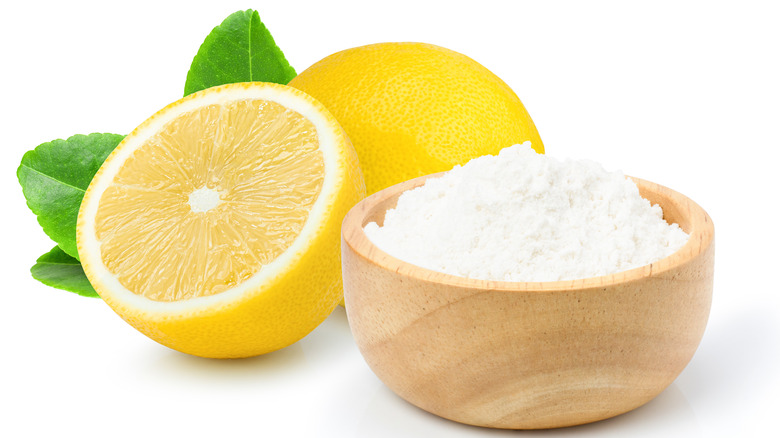The Easy Lemon Juice Trick You Need For Gauging The Freshness Of Baking Soda
We may receive a commission on purchases made from links.
As we enter the holidays, even baking-averse cooks probably have a favorite recipe that calls for baking soda. While you dust off that recipe card be sure to take a look at your baking soda, too. It's an ingredient that can get lost in your pantry (or your refrigerator) unless you make a lot of cookies and cakes. As baking soda lingers, its effectiveness is dwindling. That could have a big impact on your annual fruitcake.
According to NC State University, "Baking soda has only one ingredient: sodium bicarbonate. Sodium bicarbonate is a base that reacts when it comes into contact with acids, like buttermilk, yogurt or vinegar." Without this reaction, baked goods would end up squat and dense. NC State continues, "This process is called "chemical leavening," because the trapped CO2 gas makes the dough or batter rise."
A box of baking soda from Target is less than a dollar. That might offer the most bang for your buck of anything in your kitchen. Baking soda producer, Arm & Hammer, has dozens of suggestions for how to utilize this kitchen workhorse including cleaning and deodorizing. Also, it can impact more than baked goods. It's a boon for all sorts of foods too, from peeling eggs to tenderizing meat.
How long will baking soda stay fresh?
Arm & Hammer states the shelf life of their baking soda is three years (marked on the box). That lengthy amount of time starts to shrink as soon as you open the box. If you are using baking soda for other uses, like, as an odor absorber in your fridge, the life of baking soda could be as little as 30 days. And please, don't use your fridge baking soda for baking. Martha Stewart notes, "That baking soda has spent all that time in the fridge "grabbing" odor molecules and has since become flavored by everything that has a smell." So, keep your baking sodas separated unless you want your brownies to taste like leftover lasagne.
The Food Marketing Institute's "The Food Keeper," as noted by the USDA suggests "storing unopened baking soda at room temperature for 18 months. After opening, store at room temperature for 6 months for best quality." This is a good guideline to use for baking soda that you want to use in your baking. To avoid any confusion, America's Test Kitchen recommends using a marker to write the date you open your baking soda on the container. Once six months have elapsed from that date, you know it's time to toss that opened box and replace it with a new one. This will ensure you never need to wonder about the effectiveness of your baking soda.
Test your baking soda with lemon
Old baking soda sure looks a lot like fresh baking soda. While safe to eat, the older it is, the less it'll raise your baked goods. So, how do you tell the difference between good and bad baking soda? You could bake a batch of cookies with the questionable baking soda. But, why make all that effort (not to mention possibly waste those expensive groceries) if the baking soda really is past its prime and the recipe fails? Remember what baking soda does for baked goods. You can activate that gaseous reaction a little easier.
According to Martha Stewart, "Spoon some baking soda into a bowl (you don't need to measure it or add too much) and add a few drops of an acidic liquid, such as lemon juice or vinegar. If it starts to fizz immediately and vigorously, the baking soda will still work well for baking recipes." If the reaction is less than dramatic, it's time for some new baking soda. Once you open and date the box of baking soda, store it in a cool, dry part of your kitchen.


